The iPad Air Review
by Anand Lal Shimpi on October 29, 2013 9:00 PM ESTiPhone to iPad: CPU Changes
Although the iPad Air uses the same A7 from the iPhone 5s (and M7 motion coprocessor), there are a few minor differences that do lead to better performance.
At a high level we’re still talking about two 64-bit Apple Cyclone cores with 128KB L1s (64KB I$ + 64KB D$) per core, a shared 1MB L2 cache and a 4MB L3 cache that services the entire SoC. Apple increased CPU frequency from 1.3GHz to 1.4GHz in the iPad Air, a mild increase but in line with what we’ve seen from previous iPad designs. That’s the first impact on performance - a 7.69% increase in CPU frequency.
The second impact on performance is something I only noticed while digging around under the hood of the A7. It seems like the implementation in the iPad Air can, for whatever reason, hold more instructions in flight (over 20% more) than the A7 in the iPhone 5s. It’s unclear to me whether the A7 in the iPad is configured any differently via firmware/microcode or if perhaps we’re looking at a slightly different revision of the core, but the delta was repeatable in my testing.
The third, and likely biggest change impacting the iPad Air’s implementation of the A7 is the additional thermal headroom afforded by the larger chassis. I’m not going to go into details on exactly what this next test does (unfortunately we’re going to occlude some of the low level work that we do in light of all of the benchmark cheating going on), but we’re looking at a curve of performance vs. time for a particularly power heavy mix of code. We’re running the same exact code on both the iPad Air and iPhone 5s here, the only real difference is the size of the chassis:
You can see the 5s throttles back its CPU frequency to about 1GHz after the 2 minute mark. The crazy thing is that until that point the 5s manages to run at full frequency without so much as a hiccup for two full minutes, running an incredibly power hungry task. Given that most iOS apps aren’t this power intensive for such a sustained period of time, iPhone 5s users should almost always see the A7 running at a full 1.3GHz. Pretty crazy.
The iPad Air by comparison shows much more controlled behavior. Early on in the test we see a 7.7% performance advantage, which lines up perfectly with the iPad Air’s 7.7% CPU frequency advantage. By the end of the test the iPhone 5s has throttled to 900MHz, while the iPad Air drops to around 1.2GHz. At this point the iPad Air’s performance advantage grows to almost 40%.
CPU Performance
I've gone through our standard set of cross-platform browser based benchmarks to place the iPad Air's performance in perspective. As I mentioned in our 5s review, I don't know that there are many (any?) applications on iOS 7 that can really take advantage of all the A7 has to offer. There's definitely a ton of headroom left in the design. What's particularly exciting is when the A7 ends up in n-1 or n-2 iOS devices and it becomes the minimum developer target going forward.
I won't go through all of the results here again, but it's safe to say that the iPad Air is the fastest ARM based tablet on the planet at this point.
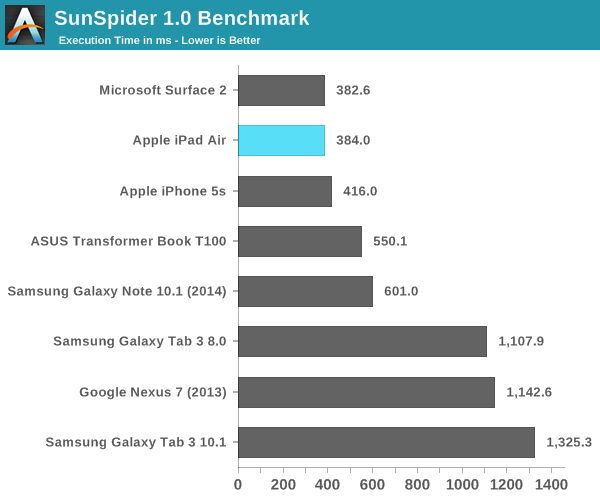
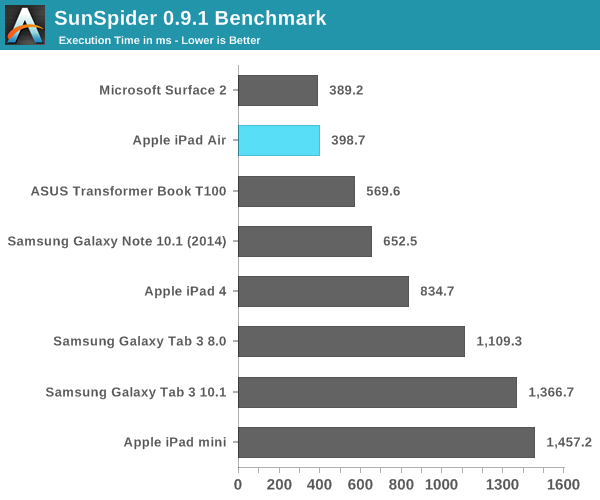
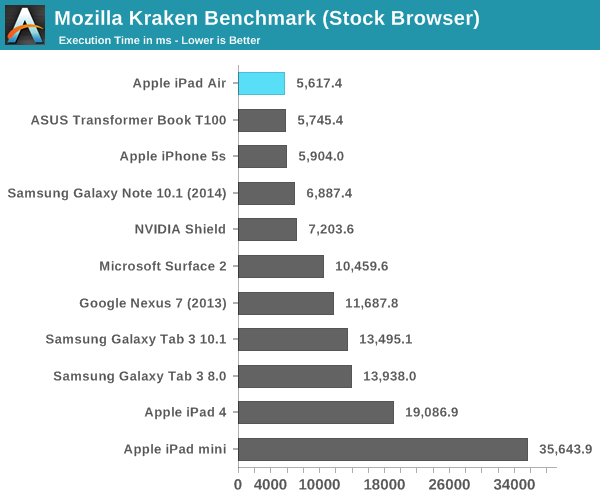
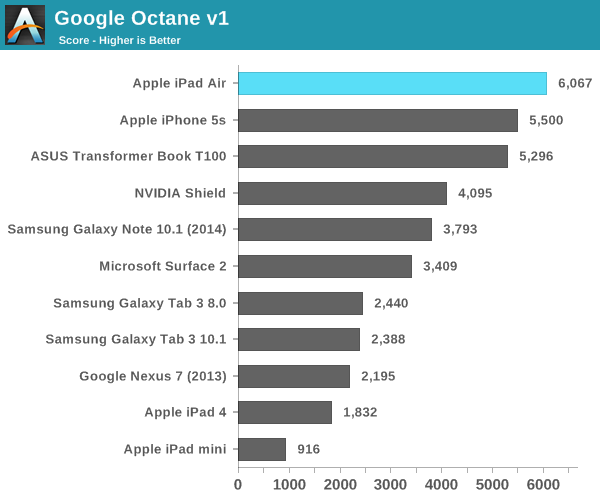
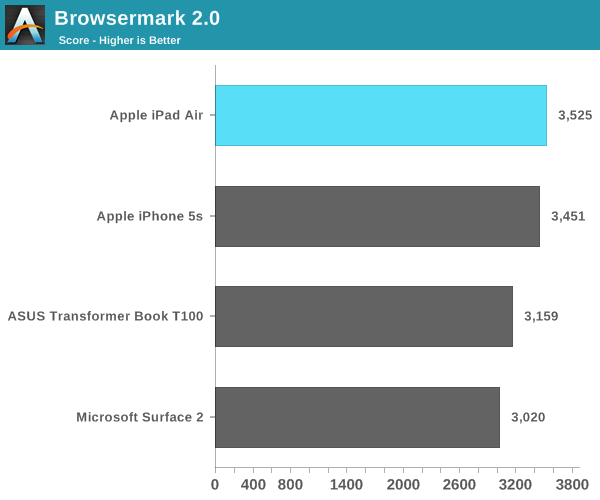

A7 Power Consumption
I’ll get to battery life in a bit, but I’ve been curious about the dynamic range of power consumption offered by Apple’s new A7 SoC. On the one hand we’re dealing with a lower power process (28nm vs. 32nm), but on the other hand Apple’s Cyclone cores can clearly draw more power given how beefy the architecture is this round. Apple frowns upon review sample dissection so I had to turn to a less scientific method of external platform level power measurement. The fidelity of the numbers here aren’t all that great but it’s better than nothing.
For the first test I measured platform power consumption during a Kraken run:
I purposely started measuring before the benchmark so I could get an idea of idle power consumption. The iPad Air consumes roughly 72% of the idle power as the iPad 4, both running at the same brightness. Here we’re not just seeing the A7’s advantages but also things like lower display power.
Focusing on the load portion of the measurement we see that both the new iPad and old iPad consume the same total power in this test. I suspect the A7 is drawing more power than the A6X, but it’s masked by a lower power display. Given how much faster the iPad Air is, Apple’s latest tablet features far lower overall task energy than the outgoing iPad 4. This is probably both the best case scenario for the iPad Air and the most likely case as well.
For kicks I wanted to see just how much power I could get the iPad Air to draw. Here I’m looking at platform power during our mini-power-virus test from above:
How’s that for dynamic range? Almost 12W running all out, but around half that in what we’d normally consider to be a stressful CPU test. I couldn’t get any actual applications/games on the iPad Air to behave like this so the results above are purely academic (for now). A quick run through GFXBench 2.7’s T-Rex HD test confirms that even pushing the GPU won’t hit these numbers. The max I saw running T-Rex offscreen was ~6W, and turning to an actual game (Infinity Blade 3) the iPad Air pulls less than 5W.


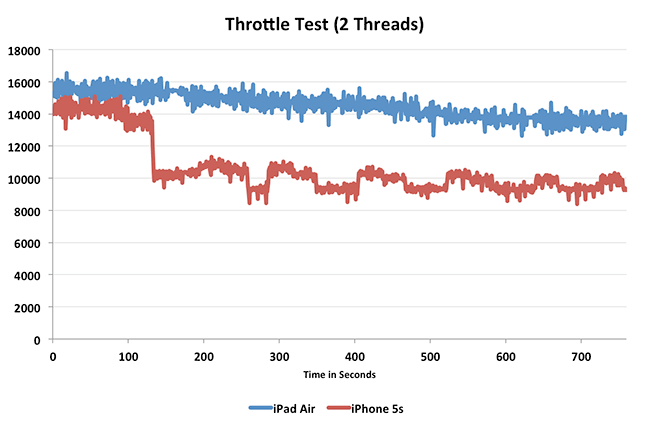
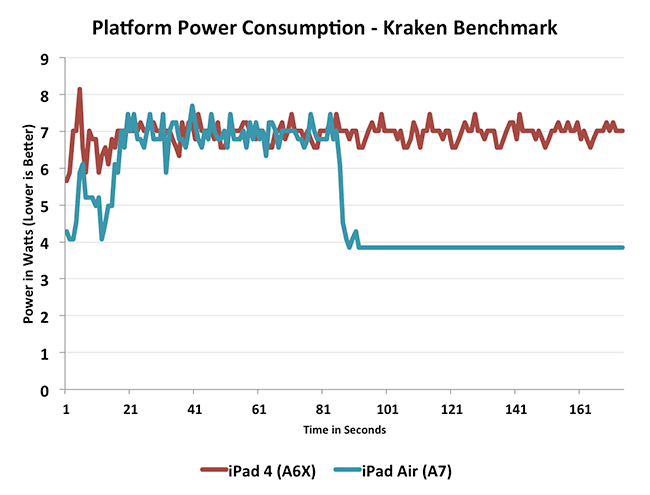
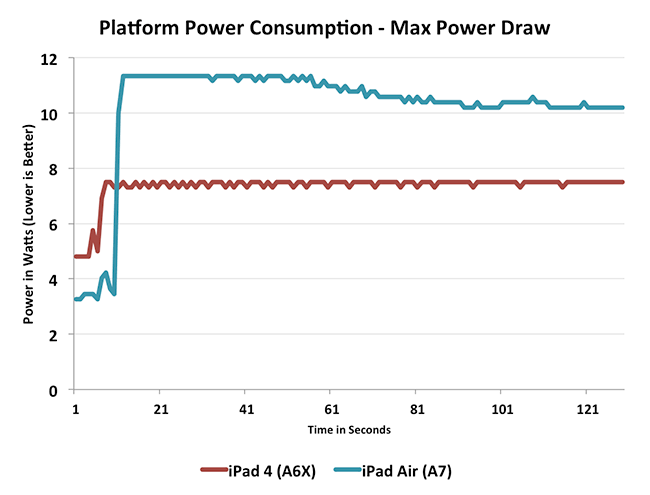








444 Comments
View All Comments
doobydoo - Friday, November 15, 2013 - link
The hardware in the HDX is slower, and it is finished in plastic. So which part was inaccurate?melgross - Wednesday, October 30, 2013 - link
There is no such thing as 100% RGB gamut. Which gamut are you talking about? sRGB? Adobe 1998 RGB? Pro RGB? There are a lot of RGB standards out there.Theard - Wednesday, October 30, 2013 - link
what Cindy implied I didn't even know that people can earn $6894 in four weeks on the computer. look at this site ... jobs23.comLizbeth - Sunday, November 3, 2013 - link
and is several price points less that the ipad airKrysto - Wednesday, October 30, 2013 - link
> is probably the higher clocked Z3770I don't see that in any tablets today, let alone smartphones. So don't say it like that, as if it's already happened. As it is, Intel's chips aren't very competitive, in both CPU and GPU performance.
> while Qualcomm will probably pass Apple's GPU early next year.
They are equal right now, at least in smartphones. The others, perhaps with the exception of Nvidia, don't really make separate "tablet chips". They make one chip for both smartphones and tablets.
Speedfriend - Wednesday, October 30, 2013 - link
"As it is, Intel's chips aren't very competitive, in both CPU"You obviously have a problem reading, given the Transformer T100 which is very close to the iPhone 5S and iPad Air in the benchmarks above, uses the Atom Z3740, which is only the second fastest. So the Z3770, which is clocked 33% higher, should be at least equal if not better than A7 in CPU benchmarks.
How in your mind that equates to not competitive I don't know..
Homeles - Wednesday, October 30, 2013 - link
Not to mention that a lot of A7's strength isn't in the silicon, it's in the software stack on top of it. All of the CPU benchmarks are done through the stock web browser -- that's something Apple can fine tune, while Intel cannot. Therefore, the A7 outperforming Atom doesn't point to Atom being weaker at a silicon level, and instead shows the advantages of being able to hand tune your OS and applications and squeeze more out of your hardware.raptorious - Wednesday, October 30, 2013 - link
I'll give you one reason: the fact that Anand omitted the iPad 4 from the latency graph in the "An Update on Apple’s A7: It's Better Than I Thought" page. Why is the iPad 4 in the bandwidth graph and not in the latency graph. I'll tell you why: because the iPad 4 has better latency and Anand doesn't want to make the A7 look bad, so he left it out. No bias? Right.syedjalalt - Tuesday, November 5, 2013 - link
Apple iPad is a great product. No doubt. The word selection for writing such important reviews has been good here. IF you go The Verge and see the iPad review, you will notice how biased and predictable they have become. Nilay Patel doesn't know anything. The guys @verge always mock Android and especially Samsung.Last year's Nexus 4's review score had 8 for camera and 9 for ecosystem(as far as I remember). This year, ecosystem is 8 and camera is 5. Great!!!1
doobydoo - Friday, November 15, 2013 - link
Yep it's ridiculous that the Nexus 4 got 8 for camera. Should have been 3/4.Ecosystem scores can vary over time so don't see the problem there. Android hasn't moved on much in the past year.